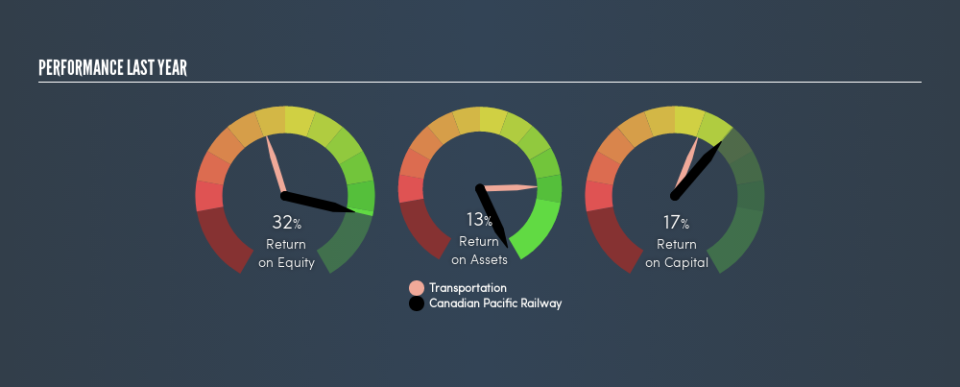Are Canadian Pacific Railway Limited’s (TSE:CP) High Returns Really That Great?

Want to participate in a short research study? Help shape the future of investing tools and you could win a $250 gift card!
Today we'll look at Canadian Pacific Railway Limited (TSE:CP) and reflect on its potential as an investment. To be precise, we'll consider its Return On Capital Employed (ROCE), as that will inform our view of the quality of the business.
First up, we'll look at what ROCE is and how we calculate it. Second, we'll look at its ROCE compared to similar companies. And finally, we'll look at how its current liabilities are impacting its ROCE.
Return On Capital Employed (ROCE): What is it?
ROCE measures the amount of pre-tax profits a company can generate from the capital employed in its business. In general, businesses with a higher ROCE are usually better quality. In brief, it is a useful tool, but it is not without drawbacks. Author Edwin Whiting says to be careful when comparing the ROCE of different businesses, since 'No two businesses are exactly alike.'
So, How Do We Calculate ROCE?
Analysts use this formula to calculate return on capital employed:
Return on Capital Employed = Earnings Before Interest and Tax (EBIT) ÷ (Total Assets - Current Liabilities)
Or for Canadian Pacific Railway:
0.17 = CA$3.4b ÷ (CA$22b - CA$1.7b) (Based on the trailing twelve months to June 2019.)
Therefore, Canadian Pacific Railway has an ROCE of 17%.
Check out our latest analysis for Canadian Pacific Railway
Is Canadian Pacific Railway's ROCE Good?
ROCE can be useful when making comparisons, such as between similar companies. In our analysis, Canadian Pacific Railway's ROCE is meaningfully higher than the 11% average in the Transportation industry. We would consider this a positive, as it suggests it is using capital more effectively than other similar companies. Separate from Canadian Pacific Railway's performance relative to its industry, its ROCE in absolute terms looks satisfactory, and it may be worth researching in more depth.
The image below shows how Canadian Pacific Railway's ROCE compares to its industry, and you can click it to see more detail on its past growth.
When considering ROCE, bear in mind that it reflects the past and does not necessarily predict the future. ROCE can be misleading for companies in cyclical industries, with returns looking impressive during the boom times, but very weak during the busts. ROCE is, after all, simply a snap shot of a single year. What happens in the future is pretty important for investors, so we have prepared a free report on analyst forecasts for Canadian Pacific Railway.
How Canadian Pacific Railway's Current Liabilities Impact Its ROCE
Current liabilities are short term bills and invoices that need to be paid in 12 months or less. Due to the way the ROCE equation works, having large bills due in the near term can make it look as though a company has less capital employed, and thus a higher ROCE than usual. To check the impact of this, we calculate if a company has high current liabilities relative to its total assets.
Canadian Pacific Railway has total liabilities of CA$1.7b and total assets of CA$22b. Therefore its current liabilities are equivalent to approximately 7.6% of its total assets. In addition to low current liabilities (making a negligible impact on ROCE), Canadian Pacific Railway earns a sound return on capital employed.
The Bottom Line On Canadian Pacific Railway's ROCE
This is good to see, and while better prospects may exist, Canadian Pacific Railway seems worth researching further. There might be better investments than Canadian Pacific Railway out there, but you will have to work hard to find them . These promising businesses with rapidly growing earnings might be right up your alley.
If you like to buy stocks alongside management, then you might just love this free list of companies. (Hint: insiders have been buying them).
We aim to bring you long-term focused research analysis driven by fundamental data. Note that our analysis may not factor in the latest price-sensitive company announcements or qualitative material.
If you spot an error that warrants correction, please contact the editor at editorial-team@simplywallst.com. This article by Simply Wall St is general in nature. It does not constitute a recommendation to buy or sell any stock, and does not take account of your objectives, or your financial situation. Simply Wall St has no position in the stocks mentioned. Thank you for reading.


